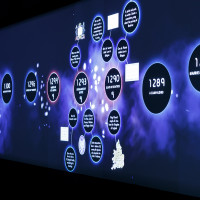
PUBLIC SECTOR
Talk to citizens
Offer advanced digital environments with which to bring citizens closer, open new spaces to interact with them, and provide innovative services.
Italy boasts a vast wealth of Cultural Heritage of a pictorial, sculptural, monumental, naturalistic, and historic nature... not to mention of a culinary nature, with over 800 food and wine products bearing certified Geographical Indications, and over 5,000 Traditional Agri-food Products. Not surprisingly, UNESCO has recognized the largest number of world heritage sites precisely within our country. And although it could serve as an extremely important resource for our economy, to the point that it has even earned the nickname of "Italian oil", this extraordinary heritage is often underestimated and poorly promoted.
In this regard, the Digital Transformation, or rather the series of digital innovations that have impacted every sector of human activity, is able to do great things, especially in terms of promoting, disseminating knowledge, enhancing the value of the territory. The starting point is always the user: in fact, the user’s way of relating to reality has changed significantly, and today this process largely takes place via a smartphone. Natural and intuitive touch interaction provides for an extremely profound and engaging multi-sensory experience, and this makes it an extremely effective and productive tool for promoting our nation’s treasures.
Having artistic, cultural and culinary attractions isn’t enough... you must also offer the most effective user experience possible in order to appeal to the public. The widespread use of digital devices by the majority of the population has resulted in a decreased attention span. Nowadays, all it takes is a few moments for people to decide whether or not they’re interested your content. So if you want your content to reach your target audience, it must make an impact and be easily accessible. It is necessary to devise an experience that uses the appeal of touch interaction and multimedia content in order to amaze and engage with the user. This is the only way to entice the public to explorer, browse, and look for the content that interests them.
As creators of Digital Environments, we design systems that bring people closer to what they’re looking for, through engaging experiences that combine illustrations, photos, videos, animations, sounds, 3D reconstructions, and text. The interactive environment allows the user to take center stage, and create a personalized pathway through which they can explore everything the territory has to offer.
Just imagine, for example, large Touch Walls installed in train stations, airports, and tourism agencies, where, via hot spots, users can access detailed information and set itineraries on a large map of the surrounding area. Unlike printed materials, these solutions can be quickly updated in order to allow for corrections, modifications, and prompt communications about local events, and are operational 24 hours a day.
The enormous potential offered by digital innovation can be effectively used to create new experiences, which don’t necessarily need to be confined to the halls of museums For example, through 3D reconstructions, the original appearance of a monument can be virtually reproduced and projected within the architectural context where it was once found. Historical eras can be revived, offering engaging experiences of extraordinary visual impact, while at the same time enhancing tours of historical places with augmented reality content. The points of attraction are thus multiplied extensively, creating a sort of wide-reaching museum that fully brings out the value of the territory.
The Public Administration often finds itself dealing with an extreme fragmentation of its tourism, culinary, and cultural heritage, and this prevents visitors from gaining a full appreciation for what the territory has to offer, even in terms of available services, such as dining, health care, law enforcement, post offices, public offices, and so on. Digital ecosystems located at strategic points with large numbers of visitors (like networks of multimedia workstations, for example) allow all of this content to be found on a single platform, from which they can be shared to the users’ smartphones and on social media.
The intuitive interaction, the possibility of creating a personalized tour of the territory, and the wealth of contents and links are extremely helpful to visitors in making their choices.
The discovery, value enhancement and digital networking of the territory aren’t only intended for visitors, but for citizens as well. Knowledge stimulates active participation in public life, leading people to establish closer ties with the Public Administration. And that's not all: digital ecosystems create a channel of immediate dialog with the end users, encouraging them to provide feedback, express their opinions, and review the services that they use. Each interaction generates information that can be appropriately collected and selected in order to provide indications useful for improving relations with citizens.
Technological innovation is leading us towards increasingly intelligent environments capable of placing the individual at the center of an engaging and fulfilling experience, which brings added value to the territory and opens up new channels of communication.

Offer advanced digital environments with which to bring citizens closer, open new spaces to interact with them, and provide innovative services.

Solutions to attract visitors, entertain them and inform them through digital engagement.

Trade shows, events, seminars, conventions, and art galleries become overwhelming experiences.

The first cycling-inspired theme park BRN Village has engaged the Touchwindow team in an exciting new digital project.

We have constantly worked in order to minimize each operation’s impact, so that the original beauty of every exhibition room could be preserved.

Blu Food, a modern restaurant located in the historic district of Porta Romana, in Milan, turned to Touchwindow to innovate its spaces, with the aim of creating a digital environment in which to experience a unique and surprising atmosphere.